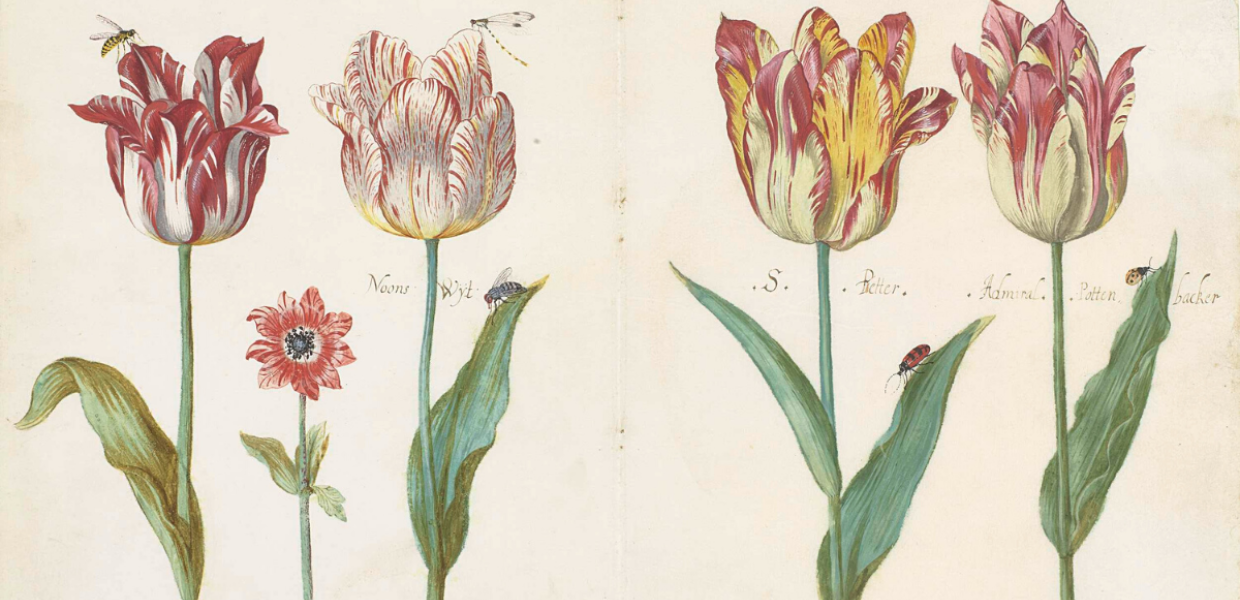Showcasing Europe’s cultural heritage through Europeana
This month on Europeana Pro we’re exploring how the new Europeana website helps audiences explore the wealth of Europe’s cultural heritage. In this post, our Collections Engagement team – who develop editorial and stories from the material published on Europeana – share their favourite aspects of the website, and the different ways that they work to encourage engagement with digital cultural heritage.

- Title:
- Sheet from a Tulip Book
- Date:
- 1640
- Institution:
- Rijksmuseum
- Country:
- Netherlands
- Copyright:
- Public Domain
Bringing collections together
Europeana’s new website brings together blogs, galleries and exhibitions on a diverse range of topics, helping audiences discover new content and showcasing the material shared through the site. Europeana Collections Manager Adrian Murphy sees the Discovering Europe page as a particularly good example.
‘At university I studied geography and I have a huge interest in travel and visiting different places across Europe. On Europeana we’ve published many blogs, galleries and exhibitions which offer portraits of places, so I’m really pleased that we now have one place which brings all these together. We can take virtual trips to cities such as Ravenna and Budapest, towns like Aveiro and Spijkenisse – we can discover the variety and beauty of European places from the comfort of our homes.’
Aleks Strzelichowska celebrates the Women’s History page: ‘We think that women's history should be visible and celebrated throughout the year, not just during the Women's History Month in March. That's why we created a page dedicated to the stories of remarkable women. You explore all our content celebrating female artists, scientists, politicians, activists in one place.’
Supporting the use of cultural heritage in education
For Isabel Crespo, Europeana’s Business Development coordinator for education, a highlight of the new site is Europeana Classroom, a dedicated space for teachers:
‘Having worked in a contemporary art museum, I know how difficult, and how important, it is for young people to encounter museum collections and their social and historical narratives. Cultural heritage institutions cannot always reach children by themselves, and it is important for educators (working in museums, archives or libraries), school teachers and families work together to create educational experiences with cultural heritage.’
‘We have listened to communities of teachers to understand their current needs and to help them develop teaching resources with cultural content. I am delighted that the new website has a dedicated online space to inspire and engage young learners and support education professionals. Explore what a teacher thinks of the new Europeana website.’
Showcasing our seasons
The Europeana website also showcases seasons, which explore a theme related to our shared cultural heritage. Marijke Everts is particularly excited about the upcoming Europeana Sport season. ‘As a child I was always quite competitive at sporting activities in my school, especially running, and I also did horse riding and rhythmic gymnastics. So I am particularly excited about Europeana Sport, which will highlight Europe’s sporting heritage and encourage everyone to share their own story on Europeana, whether it’s from the sidelines or on the field. In collaboration with sporting institutions, the events, shared stories and sporting content on Europeana will also be highlighted to our audiences through our blogs, galleries, and webinars throughout the campaign.’
Surfacing new stories
As Jolan Wuyts highlights, ‘With the relaunch of Europeana's website we now have a much more flexible way of collecting content into different topics for anyone to discover. Browse pages give us the ability to group content in ways we couldn't before. An important part is being able to surface stories and give voice to those that didn't have the privilege to be heard. With the new website we can create new spaces to showcase stories of activism and awareness. For example, the browse page on LGBTQ+ is important to me because it highlights stories that I wish I would have read when I was growing up and figuring out my own identity.’
Maggy Szynkielewska agrees: ‘I am thrilled when our work in Europeana can directly answer the needs of our users, especially those that are underrepresented. My favourite example of that is Disabilities in Art which was born as a result of collaborating with #DisabilityHistory Twitter community. They directly shaped the content of the gallery by choosing European artworks which appropriately reflects experiences and treatment of people with disabilities. Thanks to their voices and active participation we accomplished a much more apt and diverse result than by doing it alone.’
If you would like to explore the editorial highlighted in this post, visit the website and browse blogs, galleries and exhibitions. For more information on how you can share your own collections with Europeana, visit our page on how to share your data.
